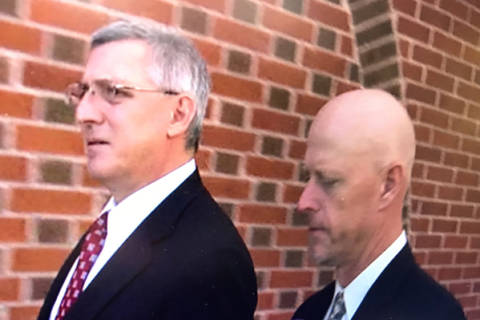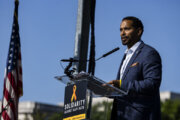LEESBURG, Va. — Lawyers for the man charged with involuntary manslaughter in the 2016 death of an infant argued in court that it was forensically and “physically impossible” for the Leesburg driver to have done anything on his smartphone that could have caused the boy’s death.
In a two-hour motions hearing in Loudoun County Circuit Court on Wednesday, defense attorney Steven Webster said although a forensic report indicated his client’s messaging app was “active” at the time of the crash, it was active for such an infinitesimal period of time that it could not have contributed to the Aug. 31 crash.
John Miller IV, 46, was indicted on a charge of felony involuntary manslaughter and misdemeanor reckless driving. He was also cited for failure to yield to pedestrians in a crosswalk.
Tristan Schulz’s mother Mindy was pushing the 5-month-old in a stroller when they were struck in a crosswalk in Landsdowne. She was seriously injured in the morning crash but survived.
Several investigators with the Loudoun County Sheriff’s Office testified about forensic testing of the Android usage file on Miller’s Samsung Galaxy 6, which offers insight into the phone’s activity.
As WTOP reported in March, testing showed Miller did not make or receive a call; did not text anyone; did not read the text he had received earlier in the day; did not access his email; did not access the internet browser; did not access voicemail; and did not access any social media applications for a half-hour before the crash.
Arguments focused on the approximately 2-minute period of time before Miller dialed 911, after the crash.
A young driver, who was in the vehicle directly behind Miller’s Jeep Cherokee told police that Miller was holding a phone in his left hand, as if he were reading or watching something.
During arguments, Webster told the judge the young driver had provided conflicting accounts of what he saw during several interviews. In one interview, the witness said he observed Miller through the Jeep’s rear window, but in another interview he recalled seeing the phone through a side window.
Webster said the passenger in the young driver’s car didn’t see the phone in Miller’s hand.
Another witness’ recollections put the young driver’s vehicle in front of Miller’s.
Deputy Commonwealth’s Attorney Sean Morgan acknowledged “there may be some discrepancies,” in eyewitness testimony, but said jurors should be able to hear about the forensics testing, as “a piece of the puzzle.”
Much of the hearing focused on the phone activity at 8:09:25 a.m., which has been identified as the time of the crash.
Christopher Hapsas, a computer crime investigator with the sheriff’s office, testified that the last app Miller used before the crash, at approximately 7:33 a.m., was his messaging app.
Shortly before the crash, Hapsas said Miller’s phone was plugged in, and his messaging app moved from the background to the foreground of his phone, then quickly returned to the background.
In his cross-examination, Webster described the launch of Conversation Composer — the user interface for the messaging app, and its retreat to the background — as “less than half-a-second,” “379 milliseconds,” and “almost instantaneous,” to make clear his client could not have been texting at the time of the crash.
However, Morgan, the prosecutor, argued the forensic analysis of what did or didn’t happen on Miller’s phone is only a portion of the prosecution’s attempt to make its case that Miller should be found criminally liable.
“It was a series of negligent acts,” said Morgan. “He ran over a mother and her 5-month-old infant, and nobody ever observed any brake lights.”
In order to prove the manslaughter charge, the Commonwealth must prove negligence or carelessness “so gross, wanton or culpable as to show a callous disregard of human life.”
Webster reminded the judge “It’s not illegal to plug in your phone or launch an app.” Virginia’s phone law expressly prohibits manually entering numbers or typing.
“They want to take something that is lawful and turn it into evidence for a manslaughter charge,” Webster argued.
Circuit Court Judge Douglas Fleming denied the defense request to have the smartphone analysis ruled inadmissible as evidence.
“If there is more than a scintilla of evidence, you’re allowed to introduce it,” as evidence, Fleming said. “Now, whether it’s lawful or not,” Fleming said, would be determined by jurors.
Fleming said the defense “can argue what weight should be given” to the forensic evidence during trial, which is scheduled to begin on Oct. 10.







